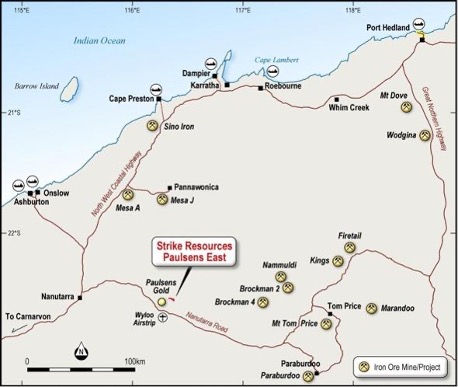Strike Resources ready to move on Pilbara iron ore after securing funding for Paulsens East mine

Pic: Getty Images
There will soon be a new player in the Pilbara iron ore game, after Strike Resources announced it is ready to bring its Paulsens East iron ore mine into production.
It comes after a dramatic rebound in iron ore prices, which have risen around 70% from under US$90/t in November to US$142/t on rising Chinese demand and analyst expectations the commodity has further upside.
That recovery supported Strike’s (ASX:SRK) decision to secure a US$7.2m ($10m) loan facility with iron ore trader and 5.26% shareholder Good Importing International to fully fund the start of development at Paulsens East.
In exchange GII will provide marketing services and/or take offtake over the life of the Paulsens East mine, ensuring a pathway into the key Asian market.
The mine will deliver around 2Mt of direct shipping ore a year over a 3.5-year mine life, backed by a probable ore reserve of 6.2Mt at 59.9% Fe and 9.6Mt indicated mineral resource at 61.1% Fe.
Work will start shortly on the construction of an 18km haulage road to connect Paulsens East to the public Nanutarra-Munjina Road so it can send its product to Port Hedland for export.

The Price is Right
Paulsens East is forecast to have life of mine C1 cash costs of US$60/t and a total life of mine breakeven price of US$87/t including costs, insurance and freight.
At current prices of US$142/t, it will see a big boost to early cashflows. At a benchmark 62% iron ore price of US$110/t, Paulsens East can make $138m in net cashflow over its life of mine.
At US$135/t, below recent prices, that could more than double to $309m.
With a staged ramp up which will see the company ship 400,000t through the existing Utah Point Facility at Port Hedland before exporting 2Mtpa through the Port of Ashburton in Stage 2, capex will be a paltry $3.4m.
Strike MD William Johnson said the company is on the way to becoming WA’s newest iron ore miner.
“Whilst iron ore prices have been relatively volatile over the last year, prices are currently sufficiently high to give the board confidence to now advance with the Stage 1 Development of Paulsens East,” he said.
“With funding for this new mine secured, Strike is now poised to become Western Australia’s newest iron ore producer.”
GII also supported the development of Strike’s high grade Apurimac mine in Peru last year through a similar US$7m pre-payment to fund first ore on ship.
“We are delighted to receive the support of Good Importing International for Paulsens. GII has already demonstrated their marketing capability and support for Strike through their offtake and funding of our Peru operations last year,” Johnson said.

Lump ore delivers big benefits
The initial 400,000t produced in 2022 will focus on high grade surface detrital ore and outcrop with a low stripping ratio that will provide cheap early cash flow to bank ahead of the larger Stage 2 development.
This will have a number of benefits, not the least the fact that 75% of the product will be a 62% lump, with the rest an average 59% fines blend.
Lump ore attracts a healthy premium over benchmark prices because it does not need to be sintered, making the steelmaking process cheaper and greener.
The detrital ore (113,000t at 60.8% Fe, 6.9% SiO2, 3.4% Al2O3 and 0.1% P) will also require no drill and blast, relying on cost effective trenching and screening mining methods.
Strike plans to use its allocated port capacity at the Utah Point facility of 200,000t per financial year over calendar year 2022.
In the stage 2 development Strike plans to export 2Mt a year from the Port of Ashburton near the town of Onslow.
With a haulage distance of just 235km from the mine compared to 600km to Port Hedland, this is expected to dramatically reduce trucking costs.
Paulsens is in a prime location near existing mining infrastructure, just 10km from the Paulsens gold mine owned by Northern Star Resources and 20km from the Wyloo Station airstrip, previously used by NST to support its FIFO workforce.
This article was developed in collaboration with Strike Resources, a Stockhead advertiser at the time of publishing.
This article does not constitute financial product advice. You should consider obtaining independent advice before making any financial decisions.
Related Topics
UNLOCK INSIGHTS
Discover the untold stories of emerging ASX stocks.
Daily news and expert analysis, it's free to subscribe.
By proceeding, you confirm you understand that we handle personal information in accordance with our Privacy Policy.








